Browsers
Learn how to browse and load ensemble presets and instrument variations from Session Percussionist’s factory library.
The Session Percussionistfactory library provides a total of 117 ensemble presets and 58 individual instruments, each instrument being available in four variations. Session Percussionistprovides dedicated Browsers to navigate through the factory library and quickly find the desired objects:
Ensemble presets contain values for all parameters of the Kontakt Instrument, including the set of players with their specific percussion instruments, the patterns assigned to the keys, the mixer settings for all players, as well as the global parameters described in the interface overview. Browsing ensemble presets is done in the Ensemble Browser.
Instruments contain recordings of single percussion instruments along with dedicated patterns. Each instrument is provided with four different mixer settings called variations and labeled A to D. Browsing instruments and their variations is done in the Instrument Browser.
Ensemble presets are stored as Kontakt Snapshots in Session Percussionist’s factory library. Therefore you will also find them in the Kontakt Browser and in the Instrument Header, however without the percussion-specific search tools available in the Ensemble Browser. Refer to Snapshotsfor more information on Snapshots. For more information on the Kontakt Browser, refer to the Kontakt manual.
Tip
A third browser is tightly integrated into the Pattern Editor and allows you to quickly find interesting patterns from the factory library: the Pattern Browser.
Ensemble Browser
The Ensemble Browser lets you find and load ensemble presets from the Session Percussionist factory library.
To open the Ensemble Browser, click the name of the current ensemble preset in the top left corner of the instrument:

The Ensemble Browser follows this typical workflow:
In the left part of the Browser, you can click the properties describing the type of ensemble that you are looking for.
In the right part of the Browser, the Results list shows the ensembles matching the properties that you have selected on the left. You can audition each of them in context before you choose one for loading.
The Ensemble Browser provides the following controls:
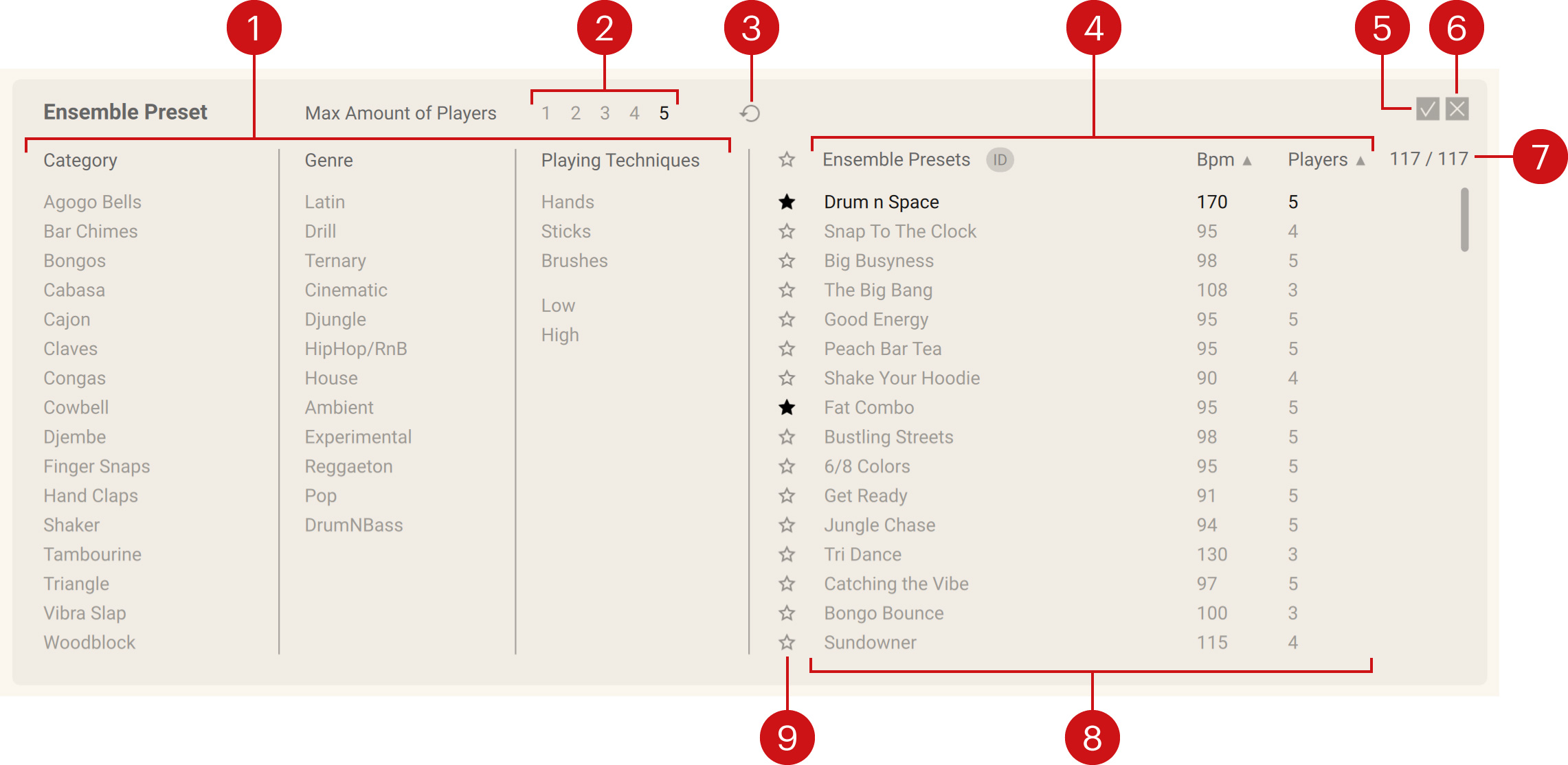
Tag filter: You can click the tags in the Category, Genre and Playing Techniques columns describing the ensemble that you are looking for. The Results list on the right is updated accordingly.
Max Amount of Players: Defines how many players can be contained in the ensemble. For example, if you are looking for a smaller combo with only two or three instruments, you would click 3 in the Max Amount of Players selector to limit the results to ensembles containing three players or less.
Reset Search: Removes any Category, Genre and Playing Techniques tags as well as the Max Amount of Players value you might have selected. In other words, this resets your search and the Results list shows again all the available ensemble presets. Note that this Reset Search button does not affect the Favorite display: if your Results list was showing only your Favorites, it will still be the case after resetting your search.
Results list headers: For each ensemble preset in the Results list, the Ensemble Presets column displays the name of each preset, the Players column indicates how many players it contains and the Bpm column shows its tempo sweet spot (in BPM), that is, the tempo region that best fits the ensemble patterns, musically speaking. You can sort the Results list according to the desired column by clicking the little arrows next to Players and Bpm, or by clicking the ID/A-Z button to sort the list alphabetically or by IDs.
OK (check mark): Keeps the selected ensemble preset loaded and closes the Ensemble Browser. This is the same as double-clicking the ensemble preset in the Results list.
Close: Closes the Ensemble Browser without changing anything. The auditioned ensemble preset is unloaded from the memory and your Kontakt Instrument returns to its previous state.
Matches: Indicate the number of matching entries over the total number of presets in the factory library.
Results list: Shows the ensemble presets corresponding to the tags that you have selected in the Category, Genre and Playing Techniques columns on the left. You can click an ensemble preset in the list once to audition it: it is temporarily loaded, you can try it on your keyboard and hear it in the context of your DAW, matching both tempo and playing position. Clicking it again stops auditioning. Once you have found an ensemble preset that fits your needs, you can double-click it to load it and close the Ensemble Browser.
Favorites: You can click the star icons to add or remove the ensemble presets to/from your Favorites. The star icons are lit for ensemble presets set as Favorites. This way, you can quickly create a custom collection of your most beloved ensemble presets. You can then display only your Favorites by clicking the topmost star icon next to the Ensemble Presets header. Click the topmost lit star icon to display also non-Favorite ensemble presets.
Locking global settings when browsing ensemble presets
Ensemble presets store values for all parameters of your Kontakt Instrument, including the Humanize, Swing, Shift, and Articulation Filter controls. Therefore, if you are auditioning different ensemble presets in the Ensemble Browser, the values of these parameters will change each time you switch between presets. This can make it difficult to compare ensemble presets in context, for example, within an arrangement in your DAW. For this reason, you can lock these four controls when browsing ensemble presets: when locked, they will keep their current values even when switching between presets.
The Humanize, Swing and Shift controls are locked together:
To lock the Humanize, Swing and Shift controls, click the lock icon that appears above the controls when the Ensemble Browser is open:
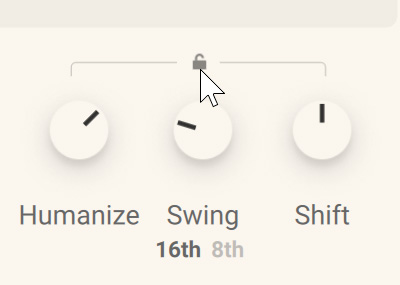
The lock icon turns on, and the position of the three knobs now stays fixed as you audition different ensemble presets in the Ensemble Browser.
The Articulation Filter can be locked separately:
To lock the Articulation Filter, click the lock icon that appears below the control when the Ensemble Browser is open:
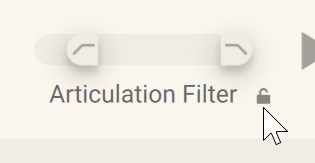
The lock icon turns on and the two handles of the Articulation Filter now stay fixed as you audition different ensemble presets in the Ensemble Browser.
Note
Even when these controls are locked, you can adjust them manually. For more information on the Humanize, Swing, Shift, and Articulation Filter controls, refer to Session Percussionist overview.
Instrument Browser
The Instrument Browser lets you find and load instrument presets from the Session Percussionist factory library. This allows you to replace the instrument of an existing player, or to add another instrument to your ensemble if a slot is free.
To replace the instrument used by a player, click the instrument category or variation name in the Instrument selector, at the bottom of the window:
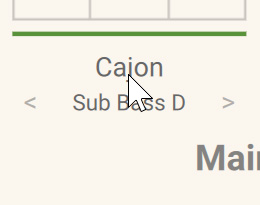
If the main page is displayed, you can also click the instrument artwork:
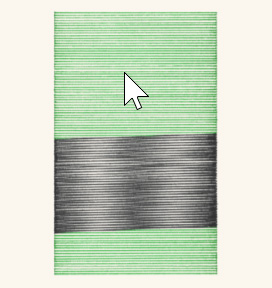
The Instrument Browser appears and lets you select another instrument or variation for that player.
To add a new instrument to your ensemble, click the “+” sign on a free slot of the Instrument selector, at the bottom of the window:

The Instrument Browser appears and lets you select an additional instrument variation for your ensemble.
The Instrument Browser follows this typical workflow:
In the left part of the Browser, you can select the properties describing the category of instrument and the playing that you are looking for.
In the right part of the Browser, the Results list shows the instrument variations matching the properties that you have selected on the left. You can audition each of them in context before you choose one for loading.
The Instrument Browser provides the following controls:
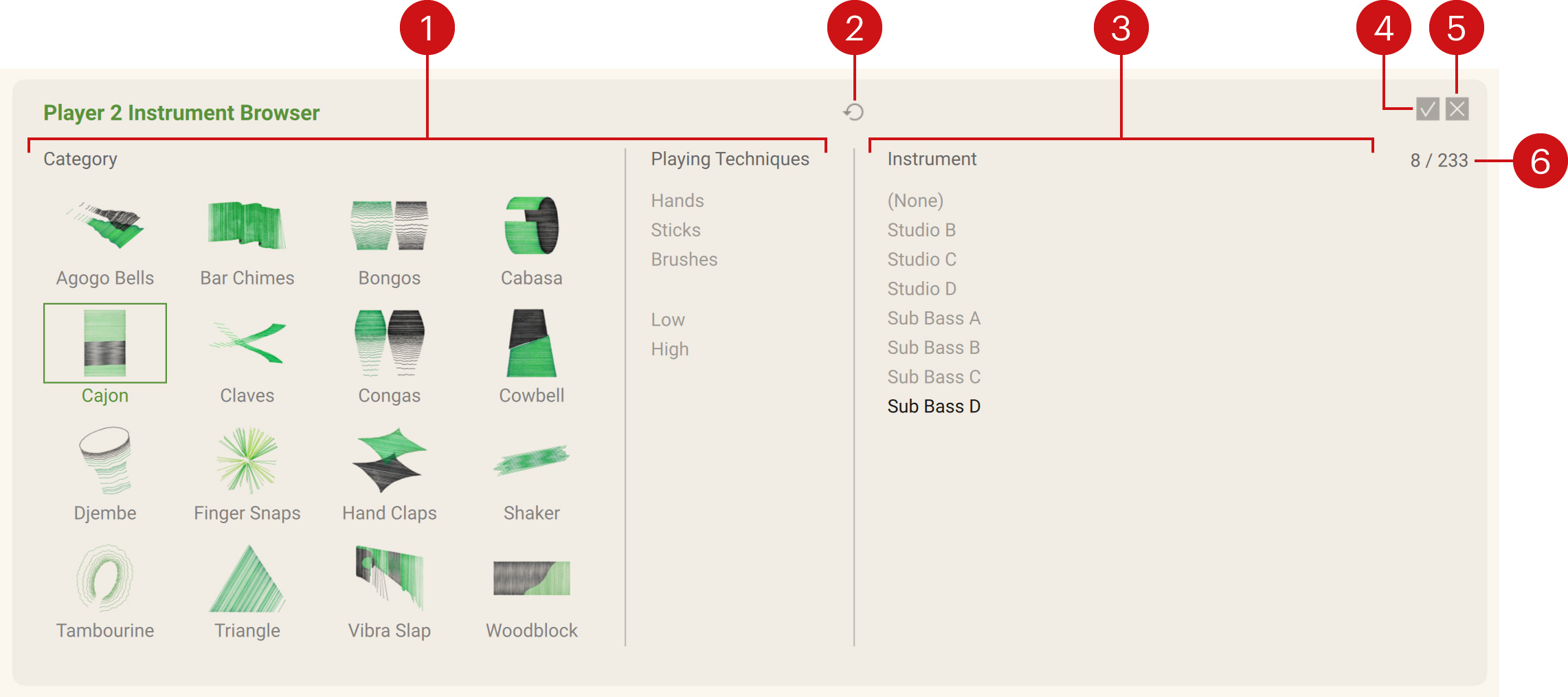
Tag filter: You can click an instrument family in the Category grid and/or a tag in the Playing Techniques column describing the instrument that you are looking for. The Results list on the right is updated accordingly.
Reset Search: Removes any Category and Playing Techniques selections that you might have made. In other words, this resets your search and the Results list shows again all the available instruments.
Results list: Shows the instrument variations corresponding to your selections in the Category grid and Playing Techniques column on the left. You can click an instrument variation in the list once to audition it: the variation is temporarily loaded onto the selected player, you can try it on your keyboard and hear it in context, even while your DAW is running: the selected instrument will then play its first pattern synced to the DAW’s tempo and playing position. Clicking the same instrument variation again stops auditioning. Once you have found a variation that fits your needs, you can double-click it to load it and close the Instrument Browser. Alternatively, you can double-click the (None) entry at the top of the list to remove the instrument from the player slot, leaving the slot empty.
OK (check mark): Keeps the selected instrument variation loaded and closes the Instrument Browser. This is the same as double-clicking the instrument variation in the Results list.
Close: Closes the Instrument Browser without changing anything. The auditioned instrument variation is unloaded from the memory and your ensemble returns to its previous state.
Matches: Indicate the number of matching entries over the total number of presets in the factory library.
Note
Instrument variations that are already loaded in your ensemble are not listed in the Instrument Browser. Each instrument variation can be used only once in an ensemble.
Locking the channel strip settings when browsing instrument variations
Instrument variations include settings for the channel strip on the Mixer. If you want to add or replace an instrument in your ensemble and are auditioning different instrument variations in the Instrument Browser, the settings on the channel strip will change as you switch between instruments variations. This can make it difficult to compare them and to determine how well they fit into your ensemble. For this reason, you can lock the channel strips: when locked, the channel strips will keep their current state when you switch between variations.
To lock the channel strips, click the lock icon next to the Mixer tab, at the bottom of the window.
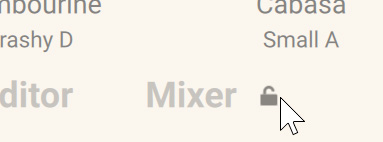
The lock icon turns on. All controls in the channel strips will now stay fixed as you audition different instrument variations in the Instrument Browser. The lock also applies when you load the next/previous instrument variation by clicking the left/right arrows in the Instrument selector.
Note
Even if the channel strip settings are locked, you can adjust them manually.
Loading another ensemble preset will always unlock the channel strips.